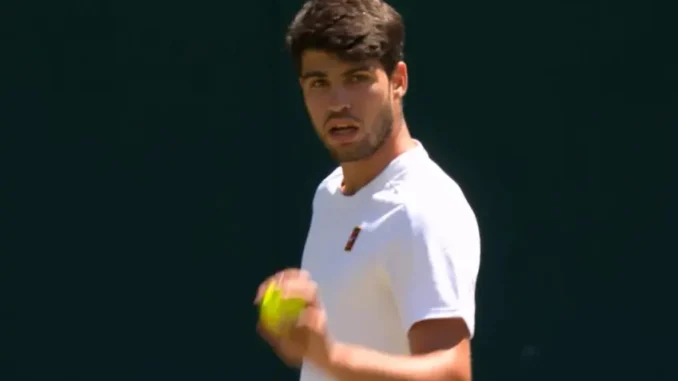
Carlos Alcaraz, the 22-year-old Spanish tennis sensation, has long been celebrated for his explosive forehand and dynamic court presence, but his serve has often been a work in progress. In the lead-up to the 2025 ATP season, Alcaraz made significant adjustments to his service motion, a move that has caught the eye of renowned coach Patrick Mouratoglou. The Frenchman, currently guiding Naomi Osaka and previously instrumental in Serena Williams’ dominance, recently took to Instagram to dissect Alcaraz’s revamped serve, praising its newfound power and fluidity. With Alcaraz’s game evolving at a rapid pace, Mouratoglou’s analysis highlights how the young star’s technical tweaks have elevated his serve into one of the most formidable weapons on the ATP Tour, setting the stage for a thrilling 2025 season.
Alcaraz’s serve has undergone a transformation, reflecting his commitment to staying competitive at the highest level. After a 2024 season that saw him claim both the French Open and Wimbledon titles, the world No. 2 recognized the need to bolster his serve to keep pace with rivals like Jannik Sinner and Novak Djokovic. During the Australian Open in January 2025, where Alcaraz reached the quarterfinals before falling to Djokovic in a gripping 4-6, 6-4, 6-3, 6-4 clash, subtle changes in his service motion were evident. “Of course, you have to change things,” Alcaraz said during the tournament, emphasizing the importance of adaptation. “To always be at the top you have to keep adapting to what’s demanded of you and changing little things to be better or just as competitive.” His tweaks, including adjustments to his racket specifications and service technique, have paid dividends, with his ATP Serve Rating now standing at an impressive 283.5, ranking among the top 10 on tour.
Mouratoglou’s breakdown of Alcaraz’s serve focuses on two key elements that underscore the Spaniard’s relaxed yet powerful approach. Analyzing side-by-side images of Alcaraz’s serve from the 2024 and 2025 Australian Opens, Mouratoglou pointed out the increased elevation of Alcaraz’s right leg and the extended follow-through of his left arm. “I see two things on that photo of Carlos Alcaraz,” Mouratoglou said. “First thing, the right leg which is going so far up, and the second thing I see is his left arm, which is going so far back also after the serve. What does it say? It says one big thing, how loose he is, how relaxed. There is no muscular tension that prevents his leg from going so far back and high. There is no muscular tension that prevents his left arm from going far to the left.” This lack of tension, Mouratoglou argues, is the cornerstone of Alcaraz’s newfound serving prowess. “If you want to create power, you need looseness. That’s one of the reasons why he has so much power in his game.”
The technical adjustments have enhanced Alcaraz’s ability to generate natural power through body rotation. Mouratoglou emphasized the importance of the left arm’s movement, noting, “I like the left arm because I’ve always said it’s very important to let the left arm go to the side when you serve because it creates natural rotation of the body, and natural rotation of the body creates natural power.” This fluidity allows Alcaraz to unleash serves with greater velocity and spin, making it harder for opponents to read and return. His improved serve was on full display during the Australian Open, where he averaged a career-high number of aces per match, a testament to the effectiveness of his off-season work. “We knew that the serve was something I had to improve, we had to do something,” Alcaraz admitted, reflecting on his pre-season focus.
Beyond the technical, Mouratoglou’s analysis underscores Alcaraz’s unique physical profile. At 6 feet, Alcaraz stands shorter than many of his top rivals like Djokovic, Sinner, and Zverev, who embody the modern trend of tall, lean players with long arms for added leverage. “Clearly there is a change in terms of body type of the tennis player for the last years,” Mouratoglou noted. “They are taller and taller, they are thinner and thinner. Look at the top guys, I mean there is one exception, Carlos Alcaraz.” Despite his compact frame, Alcaraz generates “unbelievable power,” a trait Mouratoglou attributes to his relaxed technique and explosive athleticism. This combination allows Alcaraz to compete with the tour’s biggest servers, like Giovanni Mpetshi Perricard, while maintaining the versatility that makes him a five-time Grand Slam champion.
Alcaraz’s serve evolution comes at a critical juncture. After a mixed start to 2025, marked by his Australian Open exit and withdrawals from events like the Toronto Open due to minor muscle issues, the Spaniard is under pressure to reclaim his dominance. His 2024 season, highlighted by a Roland Garros-Wimbledon double, showcased his ability to adapt across surfaces, but consistency remains a challenge. Mouratoglou believes Alcaraz’s fiery, unpredictable style compensates for this, noting, “He’s more of a puncher. But I think it’s very interesting because he can do so many different things, and he does everything so well.” As Alcaraz prepares for the US Open, where he aims to add to his 2022 title, his enhanced serve could be the key to unlocking another major.
The tennis world is watching closely as Alcaraz continues to refine his game. Mouratoglou’s glowing assessment—“The technique of Alcaraz’s serve is of a superior level!”—reflects the excitement surrounding the Spaniard’s potential. With his blend of power, spin, and showmanship, Alcaraz is not just adapting to the demands of modern tennis but redefining what’s possible. As he gears up for the hard-court swing, fans can expect more electrifying performances, with his serve now a weapon to rival his legendary forehand.
Leave a Reply